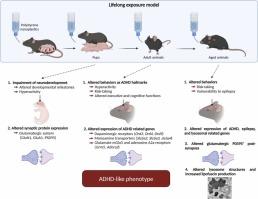终身接触聚苯乙烯-纳米塑料可诱导小鼠出现注意力缺陷多动障碍样表型并损害大脑衰老
IF 11.3
1区 环境科学与生态学
Q1 ENGINEERING, ENVIRONMENTAL
引用次数: 0
摘要
塑料废物在环境中的积累,分解成微塑料和纳米塑料,对生态系统和人类健康构成重大威胁。在人的血液、尿液和胎盘组织中检测到塑料颗粒,表明广泛的接触。虽然它们对健康的长期影响尚不清楚,但发育中的大脑,尤其是胎儿和儿童的大脑,可能很脆弱,可能导致行为改变或神经发育障碍。本研究探讨了长期暴露于23纳米聚苯乙烯纳米塑料(10微克/天/公斤)对野生型小鼠在整个生命阶段的影响,使用的暴露水平反映了人类的现实。母亲的暴露破坏了幼崽的关键发育里程碑。成年后,暴露的小鼠表现出类似注意力缺陷多动障碍(ADHD)的特征,包括多动、冒险行为增加、运动学习和执行功能受损。在衰老小鼠中,暴露与较低的癫痫阈值有关,与癫痫发作有关。这些行为改变与多动症和癫痫相关的基因和突触蛋白表达改变有关。在细胞水平上,终生接触纳米塑料会导致溶酶体功能障碍和脂褐素积累增加,表明大脑衰老加速。这些发现与人类,特别是儿童和老年人中多动症和癫痫的日益流行相一致,强调了迫切需要解决塑料污染及其对健康的影响。本文章由计算机程序翻译,如有差异,请以英文原文为准。

Lifelong Exposure to Polystyrene-Nanoplastics Induces an Attention-Deficit Hyperactivity Disorder-like Phenotype and Impairs Brain Aging in Mice
The accumulation of plastic waste in the environment, breaking down into micro- and nanoplastics, poses significant threats to ecosystem and human health. Plastic particles have been detected in human blood, urine, and placental tissue, indicating widespread exposure. While their long-term health impacts remain unclear, developing brains, especially in fetuses and children, may be vulnerable, potentially resulting in behavioral changes or neurodevelopmental disorders. This study explores the effects of chronic exposure to 23-nm polystyrene nanoplastics at 10 µg/day/kg in wild-type mice across life stages, using exposure levels reflective of human reality. Maternal exposure disrupted critical developmental milestones in pups. In adulthood, exposed mice exhibited Attention-Deficit Hyperactivity Disorder (ADHD)-like traits, including hyperactivity, increased risk-taking behaviors, and impaired motor learning and executive functions. In aging mice, exposure was associated with a lower epileptic threshold, with developing seizures. These behavioral changes were linked to altered gene and synaptic protein expression associated with ADHD and epilepsy. At the cellular level, lifelong nanoplastic exposure caused lysosomal dysfunctions and increased lipofuscin accumulation, indicative of accelerated brain aging. These findings align with the growing prevalence of ADHD and epilepsy in humans, particularly children and the elderly, emphasizing the urgent need to address plastic pollution and its health implications.
求助全文
通过发布文献求助,成功后即可免费获取论文全文。
去求助
来源期刊

Journal of Hazardous Materials
工程技术-工程:环境
CiteScore
25.40
自引率
5.90%
发文量
3059
审稿时长
58 days
期刊介绍:
The Journal of Hazardous Materials serves as a global platform for promoting cutting-edge research in the field of Environmental Science and Engineering. Our publication features a wide range of articles, including full-length research papers, review articles, and perspectives, with the aim of enhancing our understanding of the dangers and risks associated with various materials concerning public health and the environment. It is important to note that the term "environmental contaminants" refers specifically to substances that pose hazardous effects through contamination, while excluding those that do not have such impacts on the environment or human health. Moreover, we emphasize the distinction between wastes and hazardous materials in order to provide further clarity on the scope of the journal. We have a keen interest in exploring specific compounds and microbial agents that have adverse effects on the environment.
 求助内容:
求助内容: 应助结果提醒方式:
应助结果提醒方式:


